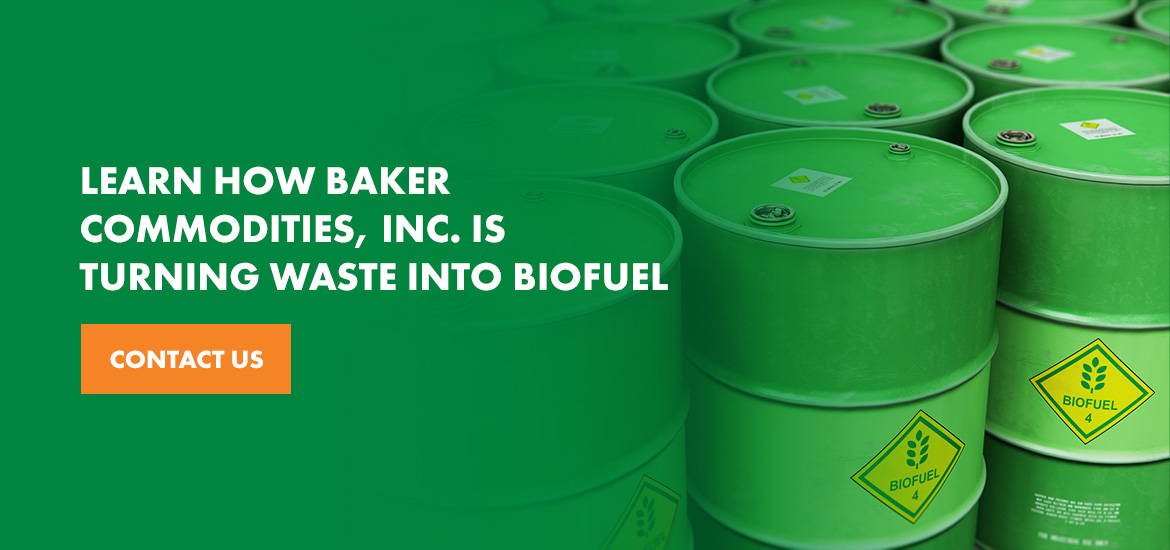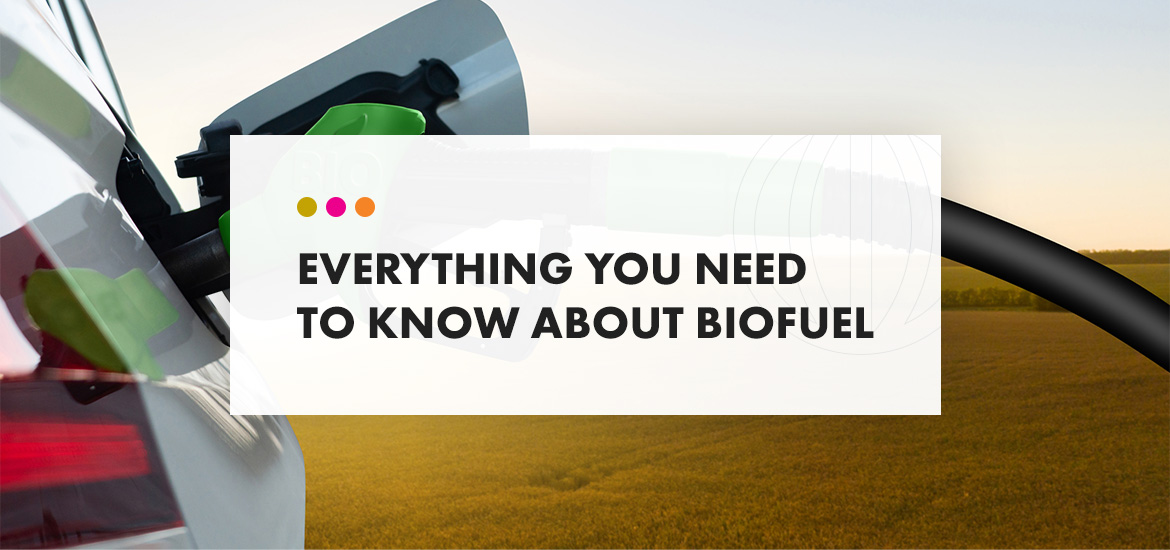Everything You Need to Know About Biofuel
Table of Contents:
- What Are Biofuels?
- Where Do Biofuels Come From?
- How Are Biofuels Used?
- Is Biofuel Renewable?
- Biofuels Pros and Cons
- Biofuel vs. Fossil Fuel
Fuel powers the equipment people use every day, from cars and trucks to generators and powered field equipment. But often, people use fuel without a second thought about where it comes from and how it impacts the environment. Many are unaware that different fuel types exist to meet their needs, and their choices can affect the planet.
Ultimately, you want that influence to be as positive as possible, and understanding the topic of biofuels is a step toward making that positive difference. By leaning into renewable energy sources for your operations, you can do your part to protect the environment. Read on to learn more.
What Are Biofuels?
Biofuels are liquid fuels that come from a material called biomass. Biomass is organic matter, primarily plant matter, that can be converted to fuel. Thus, biomass is a potential energy source in its original state. With the right conversion process, it can become biofuel, which is a usable energy source.
When you think of fuel, you may think of fossil fuels like propane, coal, petroleum and natural gas. Biofuel is a replacement for these. Results from using biofuels when replacing fossil fuels are often satisfactory, with many reports existing of cleaner, more efficient energy when using biofuels. Learn more about how biofuels affect the environment compared to fossil fuels in a later section.
According to the Energy Information Administration (EIA), there are four main categories of biofuels:
- Ethanol: Ethanol is an alcohol fuel made from sugars and plant starches like corn starch using a process called fermentation. This process introduces bacteria and yeast to metabolize plant sugars to convert biomass into ethanol. Its most common application is blending it with petroleum gasoline used for motor vehicles. When added to gasoline, ethanol increases octane while cutting down on smog-causing emissions like carbon monoxide. Ethanol is the most widely used and produced biofuel in the United States.
- Biodiesel: Biodiesel is used in blends with petroleum diesel for compression-ignition engines. It’s made from renewable resources like animal fats, vegetable oil and recycled cooking grease, then combined with alcohol.
- Renewable diesel: Renewable diesel is similar in chemical composition to petroleum diesel and works as a petroleum diesel blend or drop-in fuel. Renewable diesel and biodiesel account for 2.5 billion gallons of annual biofuel production in the United States, compared to ethanol’s 15 billion gallons.
- Other: Other biofuels include renewable jet fuel, renewable heating oil, renewable gasoline and renewable naphtha. Additional new biofuels are under development and testing for commercialization.
Where Do Biofuels Come From?
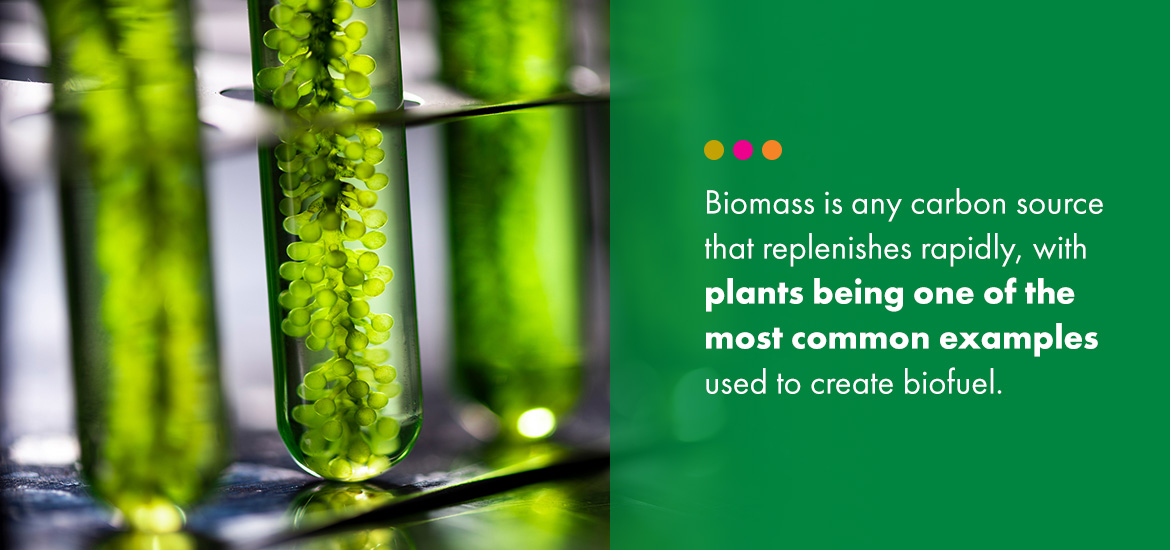
For a deeper understanding of biofuels, you need to take a closer look at biomass and the process used to convert it into usable, liquid fuel. The process of creating biofuel starts with biomass. This biological matter can come from agricultural waste, food waste, trees, grass, crops and even animal or cooking byproducts. In other words, biomass is any carbon source that replenishes rapidly, with plants being one of the most common examples used to create biofuel.
In its raw stage, biomass is only a source of potential energy. It needs a conversion process to turn it into a usable form. This is known as the biofuel conversion process, and it has two main stages:
- Deconstruction: High-temperature deconstruction uses extreme pressure and heat to break down solid biomass into a gaseous or liquid state. Low-temperature deconstruction uses chemicals or enzymes as catalysts to break down feedstocks into simple sugar building blocks.
- Upgrading: Upgrading uses chemical or biological processes to upgrade intermediates like sugars and crude bio-oils into a finished product. Upgrading can include the addition of yeast, cyanobacteria, yeast or other microorganisms to ferment sugar into chemicals and blendstocks. The finished product can be biofuels or other bioproducts.
How Are Biofuels Used?
The most popular use for biofuel is its addition to petroleum gasoline. That said, it’s extremely versatile and has many uses beyond being a fuel additive. These uses range across industries. Here are six examples of common uses of biofuel:
- Agriculture: Tractors, combine harvesters and other types of agriculture equipment rely on biofuel to sustainably plant, harvest and tend to crops throughout the growing process. As you’ll see in the section below, this is a positive arrangement since biofuel comes from many of the plants grown and harvested in the agriculture industry.
- Construction: The construction industry uses biofuels to power cranes, forklifts and other pieces of machinery that regularly use diesel.
- Power generation: Many electricity generators rely on diesel to meet their production output goals. For a more sustainable approach, many electricity generators use biofuel to get the job done.
- Heating: Commercial buildings rely on diesel for their heating needs and have started using biodiesel instead.
- Fleets: Companies are starting to adapt their trucks and other diesel-powered fleet vehicles to use biodiesel or a blend of biodiesel and standard diesel. Cars that run on petroleum gasoline can also run on ethanol instead.
- Aviation: The aviation industry has begun introducing biofuel blends into jet fuel.
Are Biofuels Renewable Energy?
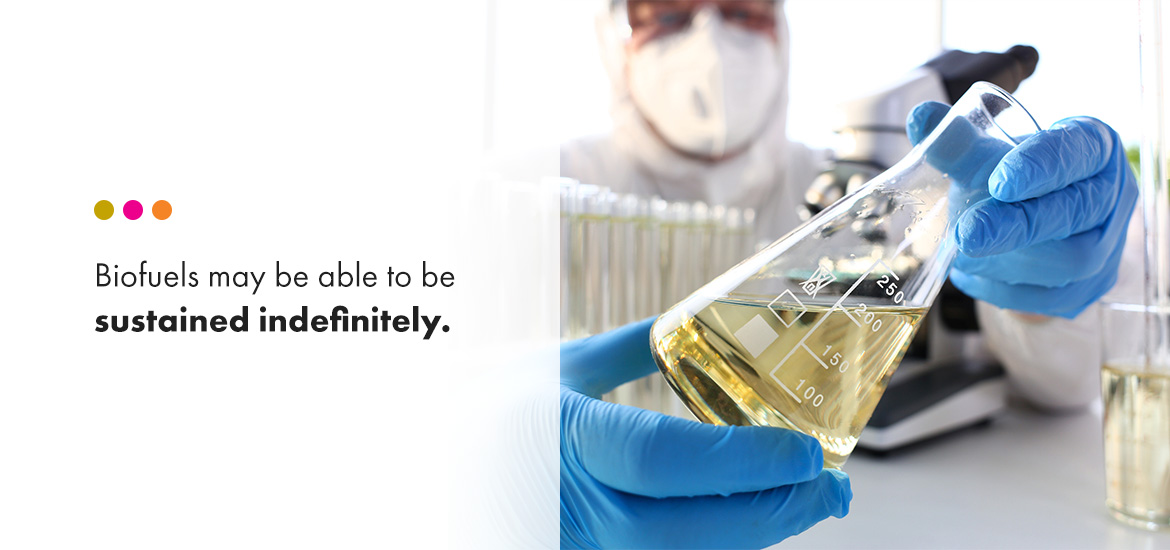
One of the main appeals of using biofuels is that they consist of renewable feedstocks. Experts in the biofuel research and development field theorize that with the right production practices, biofuels may be able to be sustained indefinitely. In other words, the rate at which we use biofuels will be equivalent to or less than the rate at which we produce biomass that we can convert into usable biofuels.
In some ways, you can think of the process almost like growing fuel. The agriculture industry grows the plants needed to create biofuel, and the process continues in an efficient, renewable cycle. Biomass can also come from byproducts of other industries, including the food service and hospitality industries, which further emphasizes biofuel’s renewability.
Biofuels Pros and Cons
As commercial industries continue to introduce more ways to use biofuel, consumers need to understand its pros and cons. While there are many advantages to using biofuel — some of which you may have already discovered in the previous sections — there are also some concerns you should be aware of. Explore the pros and cons of biofuels below.
Pros of Biofuels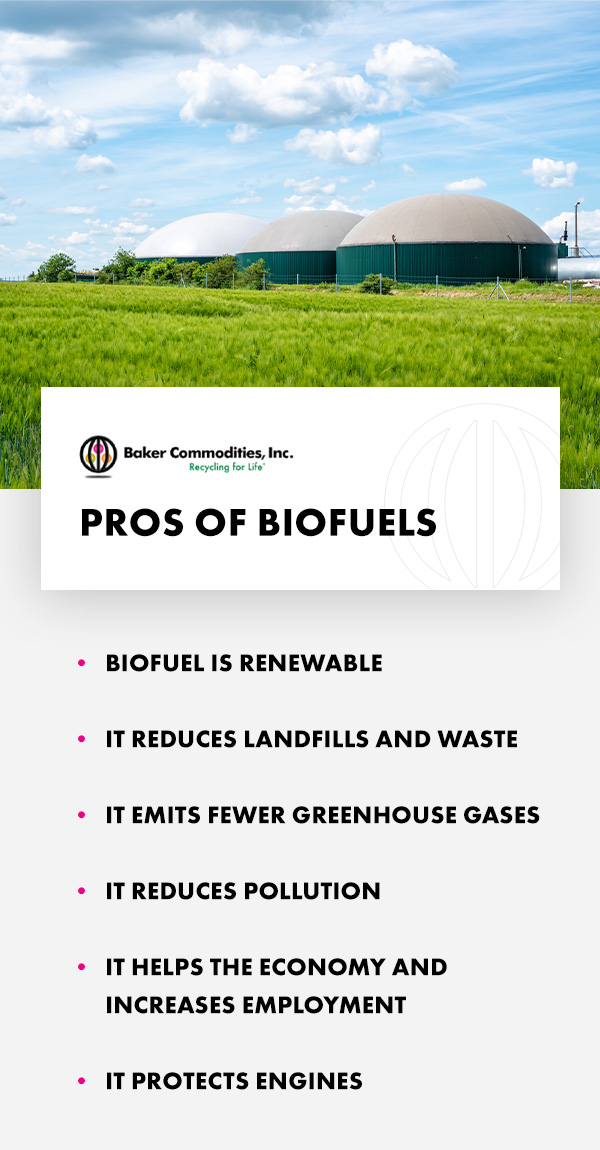
First, let’s take a look at the many positive aspects of biofuels:
- Biofuel is renewable: Biofuel uses biomass, which is a renewable source of potential energy that’s available perpetually with the right practices. This means that with enough biomass on hand, humanity can continue enjoying the benefits of biofuel for generations to come.
- It reduces landfills and waste: Consider all the potential sources of biomass that people throw away every day. With more awareness and proactive measures to recycle this biomass, energy and utility suppliers can convert it into useful biofuel. This can significantly reduce the size of landfills and ensure less waste is entering the environment over time. Put simply, when it comes to biofuel, one industry’s trash is another’s form of clean, renewable energy.
- It emits fewer greenhouse gases: Greenhouse gases contribute to climate change, and much of the greenhouse gas that humans produce comes from the burning of fossil fuels. Biofuel burns clean, emits few greenhouse gases and is completely biodegradable. Plus, the crops grown to produce biofuel absorb carbon dioxide, cleaning the air naturally. That means biofuel puts less contamination into the air while cleaning the air as part of its production process.
- It reduces pollution: Motor vehicles are some of the leading contributors to pollution worldwide. When you use biodiesel and other biofuels to power your car or truck, you’re significantly reducing the pollution you’re putting into the air. This can help improve the air quality of your town or city, especially if other people begin using biofuels for their vehicles, as well.
- It helps the economy and increases employment: Economies that produce their own biofuel can achieve greater self-sufficiency, increase their gross domestic product (GDP), create more jobs and gain more energy security. All these points can be especially helpful for developing countries that need a jump-start in their economies.
- It protects engines: Biofuels can minimize the wear and tear you exert on your vehicle’s engine. Biofuel is engine-friendly and can increase your car’s life by reducing the number of deposits and clogs that are present.
Cons of Biofuels
There are also some concerns about biofuel to consider, including the following:
- Biofuel requires a lot of water: The irrigation of crops and the production process needed to create biofuel demand plenty of water. Water is a nonrenewable resource that can experience varying levels of scarcity. Depending on the location, this concern alone may be enough to rule out the production of biofuel.
- It reduces available agricultural land for food crops: The more space farmers use for biomass production, the less space will be available for food crops. This can lead to a decrease in food crops and an increase in food prices. Baker Commodities, Inc. only uses renewable wastes to help reduce the use of agricultural land for biofuels.
- It contributes to poor crop rotation: The technique of rotating crops to conserve the nutrition in the soil is an essential technique in farming. Unfortunately, farmers can only grow a limited number of crops for biomass and biofuel production. This can lead to nutritional deprivation in soil, leading to the need for more fertilizers and pesticides. To help mitigate this, Baker Commodities, Inc. uses renewable wastes instead of relying on newly grown crops for biofuel.
- It may contribute to deforestation: Deforestation is the removal of trees for commercial reasons. It leads to animal extinction, climate change and other environmental threats. As biofuel grows in popularity, producers must be mindful of the impact such popularity can have on the world’s forests. Baker Commodities, Inc. uses renewable wastes to cut back on the impacts of deforestation.
- It has a high production cost and low yields: The process of creating biofuels is expensive. It’s also worth noting that biofuels have a lower energy density for each produced unit.
Are Biofuels Better Than Fossil Fuels?
When most people hear about biofuel as a fuel alternative, they want to know how it compares to regular fossil fuels. Here are four main points of differences between biofuel and fossil fuels:
- Sustainability: Biofuel is a sustainable energy source because it comes from plants and animal byproducts. In other words, the organic matter you use when burning biofuels was once a plant in the ground or generated as an industry byproduct. Unlike the materials used to generate fossil fuels, such as coal, biofuel comes from renewable sources we won’t likely ever run out of.
- Health and environmental impact: Biofuel is environmentally friendly. It’s clean-burning and contributes less to climate change and smog. Areas that use more biofuel can have cleaner air. Plus, less of a negative impact on the environment contributes to healthier living for the next generation. Burning fossil fuels, on the other hand, has much more of a negative impact on the environment. They can contribute to smog and poorer air quality, leading to serious health issues.
- State of the industry: The biofuel industry is growing. Although general public awareness of biofuels may be low, more people are continually learning about them and their many advantages. Because of the reduced environmental impact of biofuels, more companies are pushing for their broader use and implementation. Companies and consumers alike are seeing the many environmental concerns of fossil fuels and are seeking ways to avoid using them.
Ultimately, deciding to use biofuel depends on your applications. The most significant takeaway is that it’s a renewable energy source that’s superior to fossil fuels, so opting to use it in place of your current fuel source can provide numerous benefits for you and the planet.
Learn How Baker Commodities, Inc. Is Turning Waste Into Biofuel
At Baker Commodities, we equip you with the tools you need to recycle your process’s byproducts to reduce waste and increase your sustainability practices. We use your discarded fats, including used cooking grease from vegetable oils and animal fats, to create biofuel at our biodiesel processing plant. We also provide rendered fat byproducts to other biodiesel processing plants worldwide.
To learn more about how we can help you contribute to a more sustainable future, contact us today. We look forward to connecting with your business!
